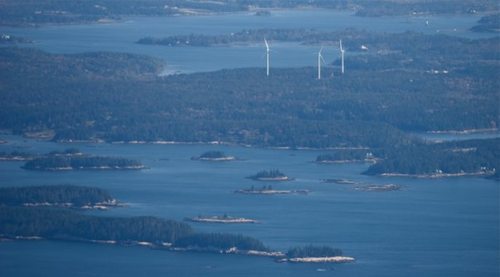It’s a beautiful idea, come to fruition: in the island communities of Vinalhaven and North Haven, Maine, a local electrical co-op joined forces with a regional nonprofit organization, and built three large wind turbines which would provide the 2,000 households on the island with locally-produced power. On a lovely fall day in November, the largest group of island residents ever gathered in one place celebrated the commissioning of the Fox Islands Wind Project. But for some residents, the moment they had been waiting for had an unexpected element: clearly audible noise.

“As I watched the first rotation of the giant blades from our deck,” says Sally Wylie in the island newspaper, The Working Waterfront, “My sense of wonder was replaced by disbelief and utter shock as the turbine noise revved up and up, past the sound of our babbling brook, to levels unimagined. It was not supposed to be this way! During informational meetings, on the Fox Islands Wind website, in private conversations, and with personal correspondence, we were all told that ambient noise from the surrounding area would cover the sound of the turbines. This was our expectation….We have found that the 45 decibel limit that is designated as ‘quiet’ in Maine, is truly a cruel joke. On our quiet cove, we now know that 45 decibels is loud.”
The community came together to dream and build the turbines, and now they are working together as well to address unexpected noise issues. Starting the day after commissioning, representatives of the wind project visited neighbors, deployed microphones, trained neighbors in how to record sound and wind speed, and asked neighbors to keep diaries of their experience of the noise. Also writing in The Working Waterfront, board members of the local electric co-op and the Fox Island Wind LLC, formed to take advantage of tax credits available for wind development, affirm that they are “committed to monitoring the sound impacts beyond the traditional approach of measuring wind speeds and decibel levels, as we have asked neighbors to also document their subjective experiences so that we can determine any other factors they may be finding bothersome. In a wide variety of ways, the Fox Islands Wind project has been a very different, first-of-its-kind, model wind project. We are committed to dealing with the sound issue in the same open and participatory way that we have approached the project since its inception.”
Once again, the experience of people on the ground, and initial recordings and conversations with neighbors, suggests that the noise is most troublesome within a half mile of the turbines, with some lesser effects out to a mile or more. According to Fox Islands Wind, “it does not appear that, except in a few individual spots, there is much impact beyond a half mile from the site.” Wylie’s conversations and recordings suggest to her that “households within a mile to a mile-and-a-half radius of the turbines are impacted by the sound.” The commentary here at AEInews is beginning to sound like a broken record, but here we go again: it is clear that we will need to make some social choices about the degree of disturbance we are willing to trade for the benefits of renewable wind energy. There is little doubt that homes within a half mile of turbines often experience elevated noise levels, and beyond that distance, impacts diminish in frequency and severity. Where will we decide to draw the line?
Fox Islands Wind Project website
The Working Waterfront, visit for ongoing coverage of the story
Island Institute community energy web info, including article on offshore wind and column in Working Waterfront on the genesis of the Fox Islands Wind project, including its economic justice/equity goals.





